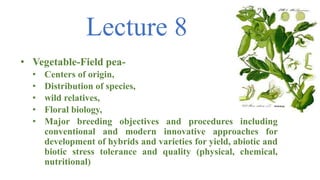
08 field pea.pptx
- 1. Lecture 8 • Vegetable-Field pea- • Centers of origin, • Distribution of species, • wild relatives, • Floral biology, • Major breeding objectives and procedures including conventional and modern innovative approaches for development of hybrids and varieties for yield, abiotic and biotic stress tolerance and quality (physical, chemical, nutritional)
- 2. • B. Name - Pisum sativum L. • Family - Fabaceae • Chromosome No.: 2n= 14 • Origin - Mediterranean region, western and central Asia and Ethiopia • Distribution – • The first cultivation of peas appears to have been in western Asia, from where it spread to Europe, China and India. • In classical times, Greek and Roman authors mentioned its cultivation as a pulse and fodder crop.
- 5. FLORAL BIOLOGY • Flowering usually begins 40 to 50 days after planting. • Flowering is normally two to four weeks, depending on the flowering habit and weather during flowering. • The flowers are arranged in the form of an axillary raceme. • The flowers may be reddish, purple or white. • They are self-pollinated and develop into 5 cm to 9 cm long, inflated or cylindrical pods containing five to 11 seeds inside them.
- 6. • Calyx: Calyx is the lowermost green tubular part of the flower. • It consists of five slightly unequal lobes called sepals. • It protects the other whorls in the bud stage from possible external injuries. • Corolla: It consist of five petals of different shapes and sizes. • The outermost petal is the largest and spreading and is known as standard or vexillum which covers the other petals in the bud stage. • The next two lateral petals look like wings. Hence they are called wings or alae. • The two innermost ones unit loosely along their ventral margins to form a boat-like structure and are known as keel or carina. • The attractive color and sweet scent of the corolla attract insects for pollination.
- 7. Breeding Objective Early maturity Pod characteristics Seed size Shelling percentage Pod yields Suitability for processing Resistance to disease
- 8. Breeding Methods 1. Breeding for abiotic stress • Breeding peas for cold resistance or cold hardiness by recurrent selection and resistance to waterlogging has been undertaken abroad. 2. Breeding for high protein and sugar content • The wrinkled seeded content 26 -33 per cent protein content and in smooth seed it is 23-31 per cent. • The inheritance of protein content is polygenically controlled and mainly by recessive factor for high protein content. • The varieties GS 195 and the local cultivar, kinnauri have high soluble protein content due to the presence of a very high number of dominant alleles.
- 9. 3. Integration of Biotechnology in Conventional Pea Breeding: • Transformation and regeneration protocols are now available in peas. • The most common method involves Agrobacterium tumefacience mediated transformation. • The major difficulty lies in the fact that this transformation is genotype specific and only a small portion of cultivars have responded to this technique. • Somaclonal variation arising from the regeneration of plants from callus, led to the use of cotyledonary meristem from freshly imbibed seed as a source of tissue for successful transformation. • The use of this technology in the pea breeding is limited to proof of concept. • Partial resistance to alfalfa mosaic virus (AMV) has been reported as a consequence of transformation with chimeric virus coat protein gene, a- amylase inhibitor (α-A 1) and the promoter phytohemagglutin, both found in French-bean when transferred to pea, have shown constitutive expression and resistance to pea weevil.
- 10. • The expression of inhibitor (α-amylase) served to block the development of the larvae at an early stage and this resulted in less seed damage and better seed quality. • This transgenic pea product could not reach to large scale field testing due to legal issues. • Transfer of herbicide resistance both as a reportable marker and a trait have also been reported, but not carried through to commercial release. • While GM crops are on increase in many parts of world with global acreage of 134 million hectares in 2009, the adverse reaction to GM crops in Europe and low rates of transfer have all contributed to the pea breeding industry not engaging in the development and release of GM peas till date.
- 11. THANKS